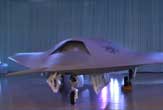
Boeing’s sleek fighter-size Phantom Ray stealth jet will make its first flight by year’s end. This unmanned airborne system (UAS) is designed for a variety of warfighter roles ranging from reconnaissance and surveillance to aerial refueling, electronic attack and hunter/killer missions.
The 36-foot-long aircraft, which will serve as a test bed for advanced technologies, was rolled out May 10 at the Boeing Defense, Space & Security plant in St. Louis, Missouri. With its 614 mph (0.8 Mach) cruising speed, operating altitude of 40,000 feet and 50-foot wingspan, the 36,5000-pound Phantom Ray advances the state of the art for unmanned aircraft. The bat-shaped flying wing has a combat radius of 1200 nautical miles. Power comes from a General Electric F404-102D engine.
Unlike earlier generation drones serving with the military in hot spots such as Afghanistan, where the aircraft is remotely controlled from the ground by a pilot using a joy stick, the Phantom Ray is capable of completely autonomous operation without the need for anyone to be at the controls, according to Boeing.
It’s more fly-by-mouse than fly-by wire. You upload a mission profile to the Phantom Ray’s onboard computer and the aircraft runs the entire mission from takeoff through mission and landing without the needs for human intervention or control unless the need arises to make changes in the mission profile.
Once airborne, the Phantom Ray will be a formidable foe. It combines high degree of survivability with a powerful arsenal of new capabilities. Its 4,500 payload can accommodate 2 large Joint Direct Attach Munitions (JDAM) or eight Small Diameter Bombs (SMB).
The aircraft was designed and developed by Boeing Phantom Works based on the X-45C prototype the company created a decade ago for the Defense Advanced Research Projects Agency (DARPA)/U.S. Air Force/U.S. Navy Joint Unmanned Combat Air System (J-UCAS) program. Phantom Works uses rapid prototyping techniques to design, develop and build advanced aircraft and then demonstrate their capabilities a quickly as possible, even if it means the final product isn't as polished or complete as it could be.
The Phantom Works is Boeing’s own “skunk works” whose mission is to “build near-operational prototypes to get airplanes flying to meet customer demands more quickly,” Chris Haddock, a communications officer in Phantom Works, told TechNewsDaily. Near operational means that not every possible system or design is onboard, he said. “It’s an 80 percent solution.”
Get the world’s most fascinating discoveries delivered straight to your inbox.
The notion driving rapid prototyping is to get a test bed for new technologies off the drawing board and into the air as soon as possible. The Phantom Ray is a technology demonstrator; it’s not meant to be a production-ready aircraft.
The Phantom Ray also flies in the face of the defense industry’s long-standing preference for projects that already have a customer and are financed by the government. This project is entirely financed by Boeing. “For the first time in a long time, we are spending our own money on designing, building and flying near-operational prototypes,” Darryl Davis, president of Phantom Works, said at the rollout ceremony.
The aircraft is scheduled to begin taxi tests this summer with the first flight scheduled for December. That will be followed by up to nine additional flights over approximately six months.


